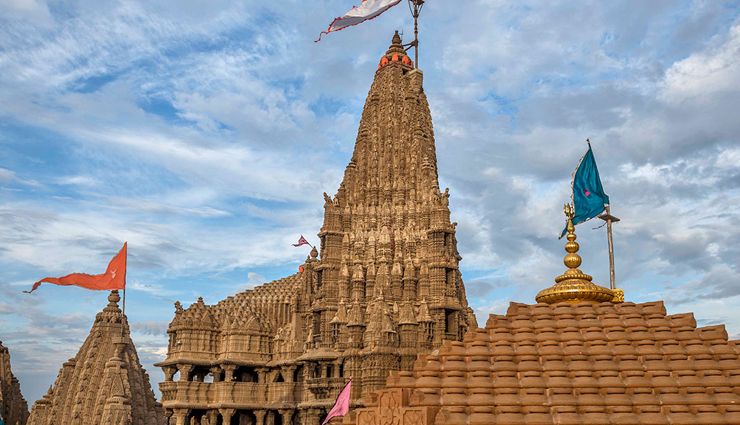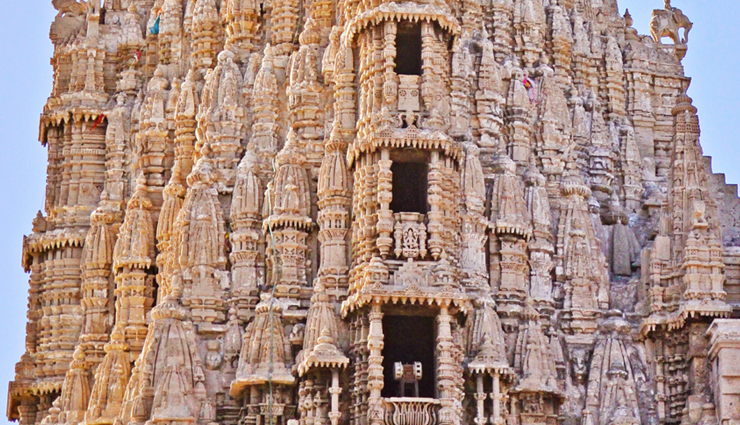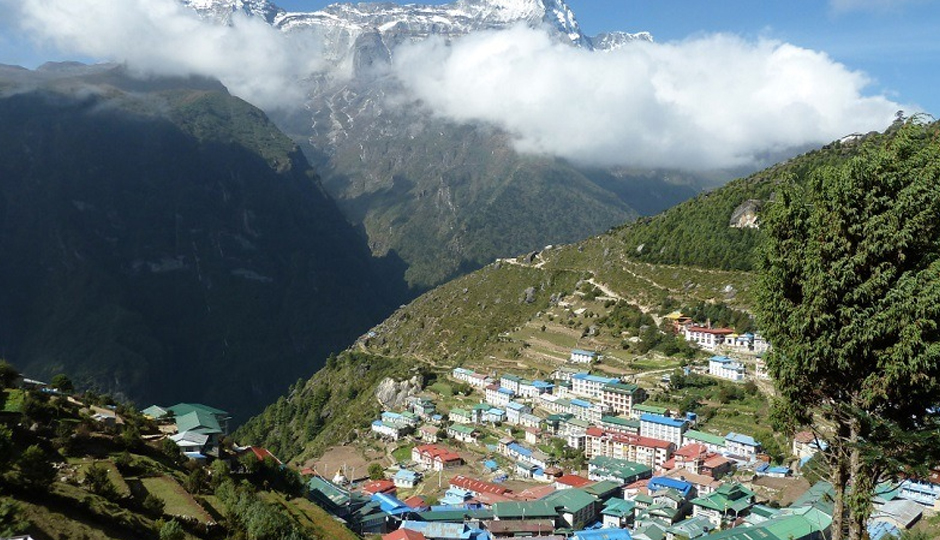History Behind The Dwarkadheesh Temple
By: Priyanka Maheshwari Wed, 06 Sept 2023 12:51:45

The Dwarkadheesh Temple, also known as the Dwarkadhish Temple, is one of the most prominent and revered Hindu temples in India. It is located in the city of Dwarka, which is situated in the western Indian state of Gujarat, along the coast of the Arabian Sea. The temple is dedicated to Lord Krishna, who is worshiped as Dwarkadhish or the "King of Dwarka" in this temple. The temple holds immense religious and historical significance for Hindus. According to Hindu mythology, Dwarka is believed to be the kingdom of Lord Krishna, and this temple stands on the site where Krishna is said to have ruled during his time on Earth. Dwarka is one of the Char Dham pilgrimage sites for Hindus, making the Dwarkadheesh Temple a significant pilgrimage destination. It is believed that a visit to this temple can help devotees attain spiritual salvation. Dwarkadheesh Temple is located on the western tip of the Saurashtra peninsula in Gujarat, overlooking the Arabian Sea. The temple's location by the sea adds to its scenic beauty and charm.

History Behind the Temple
The Dwarka temple holds great religious significance for Hindu devotees as one of the four Char Dham shrines.
Constructed using soft sandstone and sand, this temple has withstood the test of time, preserving Dwarka's unique cultural heritage for centuries. Its architectural style is a remarkable blend of Nagara and Dravidian elements, reflecting the Chalukyan style. The towering Shikhara and the massive flag it holds carry deep symbolic importance in Hindu tradition and culture.
Located proudly on the banks of the Gomati River, this magnificent temple contains shrines dedicated to Lord Krishna, Balarama, Subhadra, Rukmini, and various other deities and influential mythological figures.
The temple's present structure was erected in the 15th-16th century under the patronage of Raja Jagat Singh Rathore. However, archaeological evidence suggests that it was constructed on the site of an earlier temple. According to Hindu religious texts, the original temple was built some 2000 years ago by Sri Krishna's great-grandson Vajranabha on the site of Krishna's royal Dwarka palace.

The Birth of the Temple
The history of the Dwarkadheesh temple traces back to the time when Lord Krishna defeated his wicked uncle, Kans. Following this victory, Krishna, along with the entire Yadava community, departed from Mathura. He established a splendid town on the banks of the Gomati River, naming it 'Swarnadwarika.'
Lord Krishna took up residence in the regal palace of Dwarka, which eventually submerged in the sea along with the city itself. Many generations later, his great-grandson, Vajranabha, constructed a temple known as Dwarkanatha as an expression of his devotion to Lord Krishna. Legend has it that Vajranabha, with the aid of a mysterious force, erected the temple in a single night.
Another tale associated with the temple involves Mira Bai, a fervent devotee of Sri Krishna. Mira Bai was subjected to poison by her father-in-law, but the poison had no adverse effects on her. After consuming the poison, she visited the temple, and by the following morning, only her Ektara (stringed instrument) and Kartal (cymbal) remained at the feet of Krishna's idol. Many believed that Mira Bai had merged with the idol and attained Moksha (spiritual liberation) at this sacred place.

Architectural Significance
The Dwarkadheesh temple stands as a magnificent example of divine Hindu temple architecture. The current temple structure follows the Chaulkyan architectural style, which was prominent during the 16th century. The temple's grandeur spans an impressive area measuring 27 by 21 meters, with its tallest peak soaring to a height of 52 meters.
Constructed primarily from limestone, this splendid temple features two gateways, namely the Swarga Dwaram (Gate to Heaven), serving as the entrance, and the Moksha Dwaram (Gate to Liberation), serving as the exit. To access the Swarga Dwaram, which faces the Gomti River, devotees ascend 56 steps and typically purify themselves with a bath in the sacred Gomti River before entering.
The temple complex comprises five stories supported by 72 pillars that reach heights of over 100 feet. Its exteriors are adorned with intricate carvings depicting scenes from Krishna's life, portraits of Dwarka's rulers, and various religious symbols. The temple's design exudes a sense of mythical significance and maintains remarkable continuity throughout.
Inside the temple, you'll find a striking simplicity, with the elaborately ornate idol of the Lord in the sanctum sanctorum standing as the focal point among the interior elements. The main deity is portrayed in the Trivikrama form of Lord Vishnu, adorned with four arms (as Lord Krishna was an avatar of Lord Vishnu).

Spiritual Significance
The Dwarka temple holds a place of reverence among the trio of pilgrimage destinations linked to Lord Krishna and is a constituent of the 48 Kos Parikrama, a sacred circumambulation.
Furthermore, the Dwarkadheesh temple is the 98th Divya Desam out of the 108 sacred sites devoted to Lord Vishnu. Notably, the flag atop the temple's spire bears symbols representing the sun and moon, signifying that Krishna's presence endures as long as the sun and moon grace Bhoolok (the Earth).
Dwarka is acknowledged as one of the seven sacred cities of India, collectively known as the Sapta Puri. Additionally, the Dwarkadheesh temple serves as the seat of Dwarka Peetha, which is one of the four Peethas, or religious centers of Hinduism, forming the Char Dhams.
Established by Adi Shankaracharya, the eminent Hindu philosopher and saint of the 8th century, these Peethas hold profound spiritual significance. The other three Peethas are situated in Puri in the East, Badrinath in the North, and Rameshwaram in the South. Adi Shankaracharya, a prominent Hindu saint, is noted for his visit to the Dwarkadheesh temple. The temple's walls bear images and designs depicting the life of Adi Shankaracharya.
Special Ceremonies & Festivals
The Dwarkadheesh temple committee adheres to the rituals prescribed by the Pushtimarg tradition, which was introduced by the 16th-century Hindu saint Vallabhacharya. Daily observances commence with the Mangal Aarti, a morning worship, held at 6:30 am. Devotees can have a sacred view of the deity until noon, followed by the organization of the Rajbhog, a royal lunch gathering within the temple. The temple doors are closed at 9:30 pm every night following the Shayan Aarti.
In addition to these daily rituals and Poojas (religious ceremonies), Dwarkadheesh also observes numerous Hindu festivals with great enthusiasm.
One of the most significant celebrations at the temple is the Temple Flag festival, which draws both Indian and international visitors. This festival marks the birth of Lord Krishna, and during this occasion, the deity is revered in his infant form. Dwarka city is adorned like a queen on this auspicious day, attracting millions of devotees who throng the temple seeking blessings. The air is filled with the sounds of Bhajans (religious hymns) originating from the temple, resonating throughout the city.





